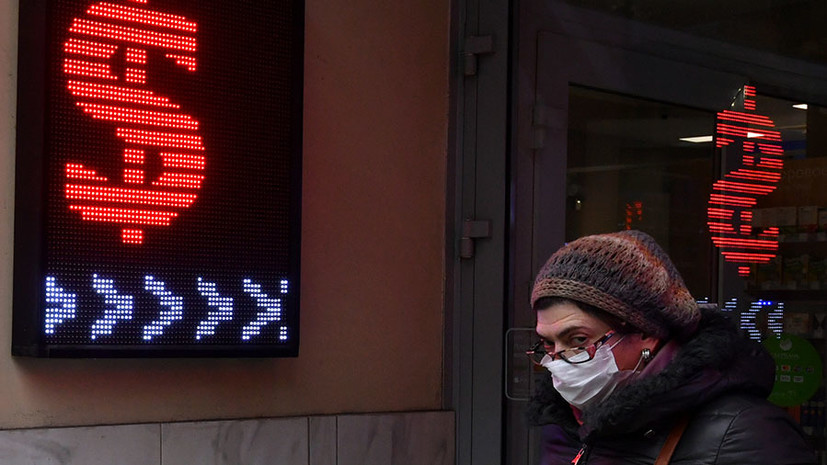On Monday, March 30, the Russian currency shows a weakening on the Moscow Exchange. At the opening of trading, the dollar rose by 2.5% - to 80.8 rubles, and the euro - by 1.6%, to 89.1 rubles.
Negative dynamics are also shown in the Russian stock market. The Mosbirzhi index fell by more than 1.8% to 2357.5 points, and the RTS index fell by almost 3% to 926.8 points.
The depreciation of the national currency and Russian securities occurred against the backdrop of a record collapse in world oil prices. On Monday, on the ICE exchange in London, the cost of Brent benchmark grade energy decreased by more than 9% to $ 22.7 per barrel. The value has become the lowest since November 2002.
As TeleTrade chief analyst Mark Goikhman told RT, one of the main reasons for the fall in oil prices was the news about the spread of coronavirus. According to official data from the World Health Organization (WHO), the total number of people infected in the world exceeds 638 thousand, more than 30 thousand infected have died. At the same time, specialists at the Johns Hopkins American University estimate the number of cases at 735 thousand, and the number of deaths at almost 35 thousand.
The spread of the disease and quarantine measures have already provoked a massive reduction in trade, passenger traffic and fuel demand. As a result of the drop in energy consumption, the cost of oil also decreases.
“The International Energy Agency is already forecasting a drop in oil demand due to the pandemic by about 20%. At the same time, from April, Saudi Arabia and OPEC countries plan to increase production and exports even more, deliberately dropping prices to increase their market share. That is why quotes have fallen to a minimum for 17 years and are trading near $ 23 per barrel, ”said Goikhman.
According to analysts, to a certain extent, ruble dynamics was affected by the announcement of a non-working week in Russia and the introduction of enhanced quarantine in Moscow in connection with COVID-19. Investors fear a decline in consumer demand and possible financial losses of the business.
“Quarantining people hinders production, and reduced demand for services and goods puts pressure on the business and budget of the country as a whole,” Alyona Lapitskaya, independent expert on personal investments, told RT.
Meanwhile, the weakening of the national currency is restrained by the measures of global central banks to support the global economy. So, for example, on March 23, the US Federal Reserve announced an unprecedented expansion of the quantitative easing program.
The regulator plans to buy bonds in the stock market in an unlimited volume. Such a policy should lead to an increase in the money supply in the economy and help increase GDP growth rates. It is expected that similar measures can be taken by other central banks, thereby supporting demand for the Russian currency and other risky assets.
“Exceptional measures by the US and world central banks to inject huge amounts of liquidity into the economy to maintain demand, compensate for losses and reduce revenues limit the sale of risky assets, which include the ruble,” said Goikhman.
Moreover, the support of the national currency is provided by the actions of the Bank of Russia. Recall, to stabilize the ruble since March 10, the Central Bank began proactive sale of foreign currency on the domestic market. Thus, the regulator artificially increases the demand for rubles.
Over the past few weeks, the Central Bank has increased daily foreign currency sales from 3.6 billion to 13.8 billion rubles. At the same time, the Central Bank acted in support of entrepreneurs in favor of the national currency and the financial system as a whole, said Artem Deev, head of the analytical department at AMarkets.
“At the last meeting, the regulator kept the rate at 6% of the year, and currently provides the markets with ruble and foreign currency liquidity. It was decided to postpone tax penalties for air carriers and tour operators, expanded lending programs for small and medium enterprises and temporarily suspended inspections of entrepreneurs, ”said Deev in an interview with RT.
According to analysts, the further dynamics of the ruble will continue to largely depend on fluctuations in oil prices and the scale of distribution of coronavirus in the world. Mark Goikhman does not exclude the possibility of a dollar appreciation to 83 rubles in the coming month in the event of an exacerbation of the pandemic. Meanwhile, a weakening epidemic can provoke a strengthening of the national currency.
“If the peak of the pandemic recedes and oil prices rise to the range of $ 25-30 per barrel, the dollar may drop to 75-77 rubles," the analyst concluded.

